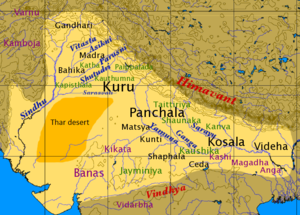Videha | |||||||||
|---|---|---|---|---|---|---|---|---|---|
| c. 1100 BCE–c. 7th century BCE | |||||||||
 The Kingdom of the Videhas and other kingdoms of the late Vedic period | |||||||||
 Republican Videha (ruled by Vajjika League) among the Gaṇasaṅghas in the Post-Vedic period | |||||||||
| Status | Kingdom (earlier) Republic of the Vajjika League (later) | ||||||||
| Capital | Mithila, which could either be Janakpur (in present-day Nepal),[1] or Baliraajgadh (in present-day Madhubani district, Bihar, India).[2][3] | ||||||||
| Common languages | Sanskrit | ||||||||
| Religion | Historical Vedic religion[4] | ||||||||
| Demonym(s) | Vaideha | ||||||||
| Government | Monarchy (earlier) Aristocratic republic (later) | ||||||||
| Rājā (earlier) Gaṇa Mukhya (later) | |||||||||
| Legislature | Sabhā | ||||||||
| Establishment | By Videgha Mathava | ||||||||
| Historical era | Iron Age | ||||||||
• Established | c. 1100 BCE | ||||||||
• Republic Vajjika League dethroned monarchy Viedha dynasty | c. 7th century BCE | ||||||||
| |||||||||
| Today part of | India Nepal | ||||||||
Videha (Prākrit: 𑀯𑀺𑀤𑁂𑀳 Videha; Pāli: Videha; Sanskrit: Videha) was an ancient Indo-Aryan tribe of north-eastern Indian subcontinent whose existence is attested during the Iron Age. The population of Videha, the Vaidehas, were initially organised into a monarchy but later became a gaṇasaṅgha (an aristocratic republic), presently referred to as the Videha Republic, which was part of the larger Vajjika League.
- ^ Raychaudhuri (1972)
- ^ "News18 इंडिया: Hindi News, Latest News in Hindi, Breaking News in Hindi".
- ^ "नालंदा ने आनंदित किया लेकिन मिथिला के बलिराजगढ़ की कौन सुध लेगा ? | News of Bihar". Archived from the original on 26 October 2017. Retrieved 26 October 2017.
- ^ Ben-Ami Scharfstein (1998), A comparative history of world philosophy: from the Upanishads to Kant, Albany: State University of New York Press, pp. 9-11